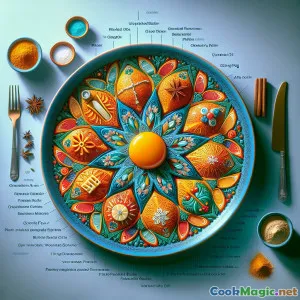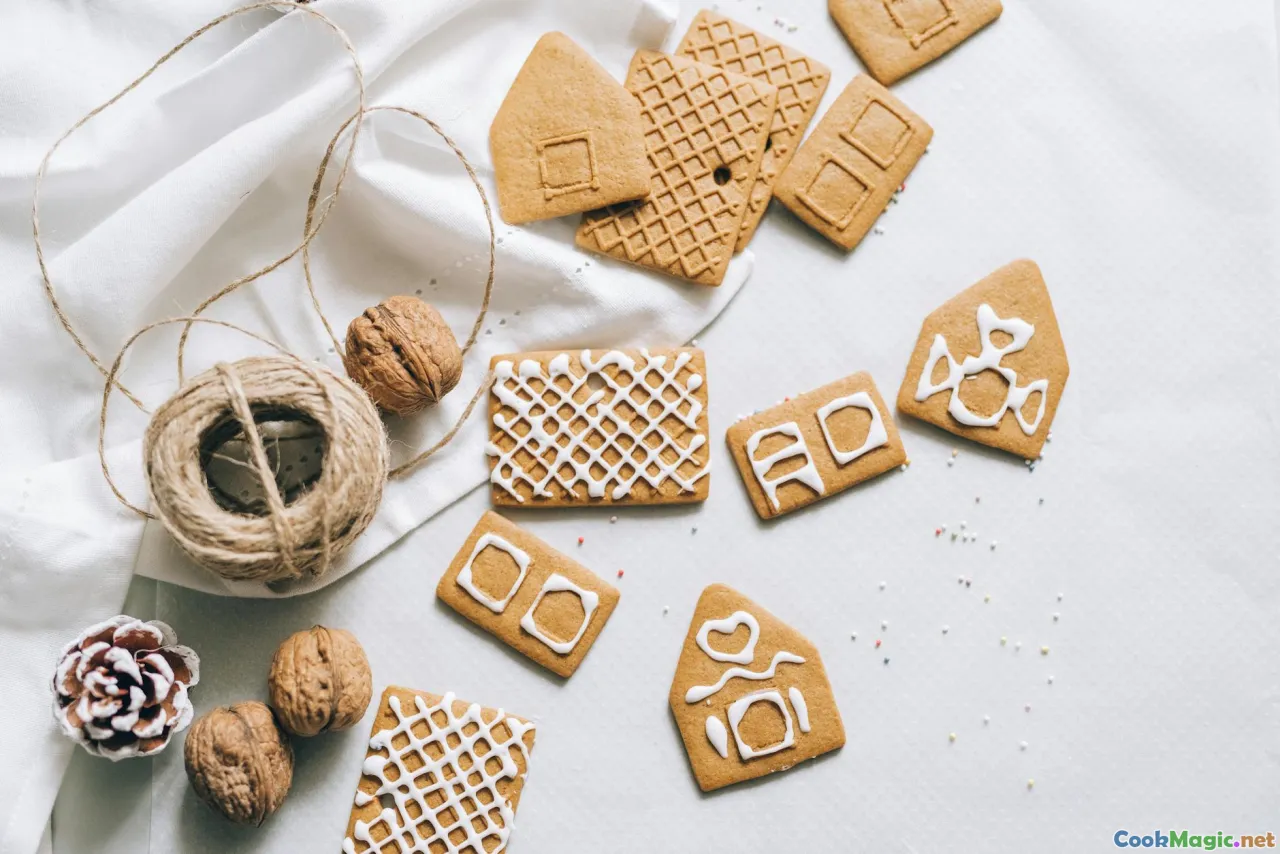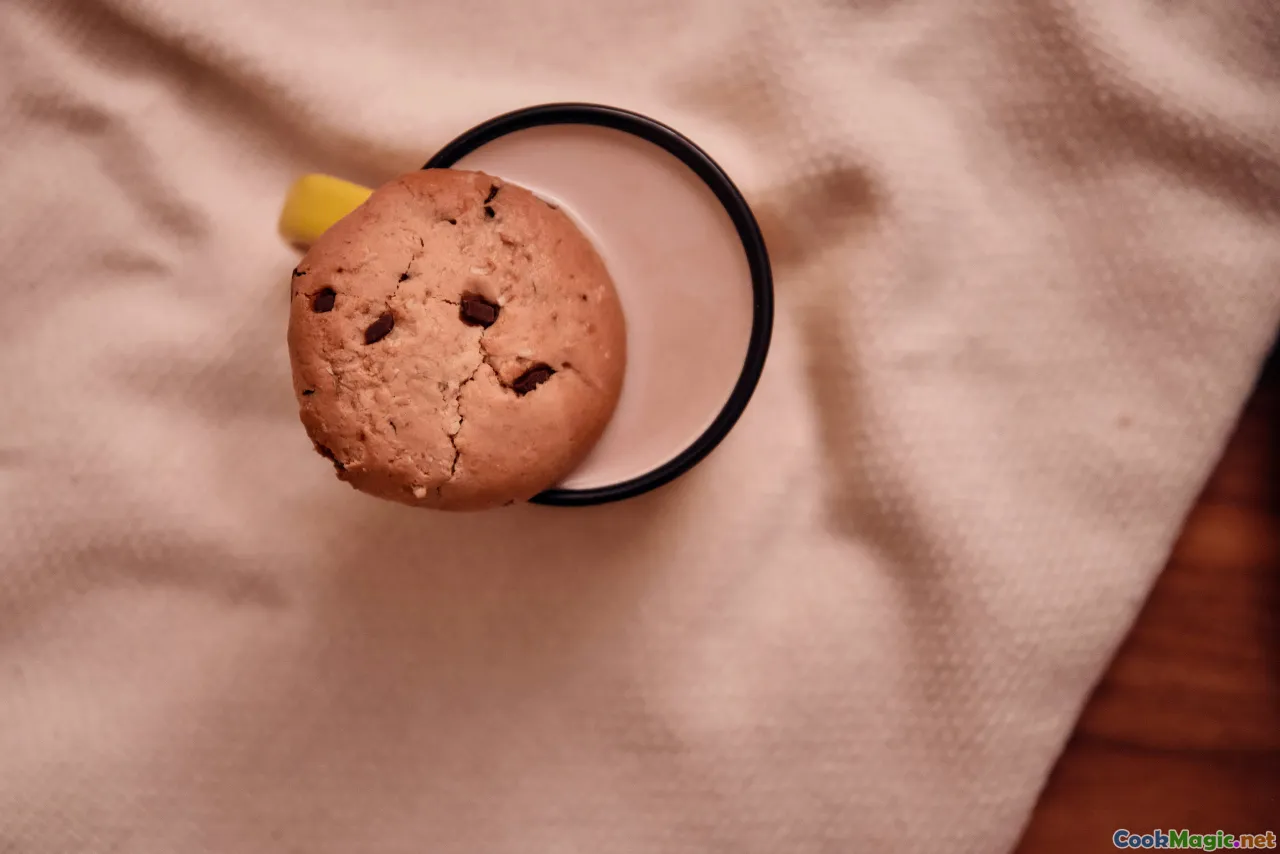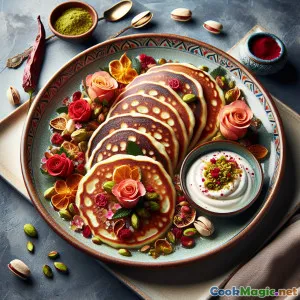
糖衣的委内瑞拉 Panela 与 茴香卡塔琳娜
(Glazed Venezuelan Panela Anise Catalinas)
(0 评论)食材
-
250 grams 蔗糖块(panela),磨碎
(Unrefined cane sugar block; deep molasses flavor)
-
180 ml 水
(For making panela syrup)
-
80 grams 无盐黄油,室温软化
(For richness; room temperature)
-
30 ml 植物油
(Adds tenderness and shine)
-
1 large 大鸡蛋
(Adds structure; omit for traditional eggless style)
-
360 grams 通用面粉
(Spoon and level for accuracy)
-
6 grams 泡打粉
(About 1 1/2 teaspoons)
-
3 grams 小苏打
(About 1/2 teaspoon; helps browning)
-
2 grams 茴香粉
(Intensifies aroma throughout the dough)
-
4 grams 整粒小茴香籽
(Pleasant crunch and bursts of flavor)
-
1 grams 肉桂粉
(Warm spice note)
-
3 grams 细海盐
(平衡甜味)
-
2 grams 新鲜橙皮
(Citrus lift; from 1 small orange)
-
5 ml 香草提取物
(Rounds the flavors)
-
80 ml 潘纳拉糖浆(用于上釉)
(Set aside from step 1; for brushing)
(Unrefined cane sugar block; deep molasses flavor)
(For making panela syrup)
(For richness; room temperature)
(Adds tenderness and shine)
(Adds structure; omit for traditional eggless style)
(Spoon and level for accuracy)
(About 1 1/2 teaspoons)
(About 1/2 teaspoon; helps browning)
(Intensifies aroma throughout the dough)
(Pleasant crunch and bursts of flavor)
(Warm spice note)
(平衡甜味)
(Citrus lift; from 1 small orange)
(Rounds the flavors)
(Set aside from step 1; for brushing)
营养
- 份量: 8
- 每份大小: 2 cookies (60 g)
- Calories: 410 kcal
- Carbohydrates: 66 g
- Protein: 6 g
- Fat: 13 g
- Fiber: 1.5 g
- Sugar: 32 g
- Sodium: 420 mg
- Cholesterol: 45 mg
- Calcium: 70 mg
- Iron: 1.5 mg
制作步骤
-
1 - Make panela syrup:
Combine grated papelón and water in a small saucepan over medium heat. Stir until dissolved, then simmer 3 to 4 minutes until slightly thick, like warm maple syrup. Measure out and reserve 80 ml for glazing. Let the remaining syrup cool until warm, not hot.
-
2 - Preheat and prepare pans:
Preheat oven to 180°C. Line two baking sheets with parchment or lightly grease. If your kitchen is warm, clear space in the fridge for chilling shaped cookies.
-
3 - Mix aromatics and fats:
In a large bowl, beat softened butter with vegetable oil until glossy. Add ground anise, anise seeds, cinnamon, salt, orange zest, and vanilla. Mix until fragrant. Beat in the egg, if using. Stream in the warm panela syrup and mix until cohesive.
-
4 - Combine Dry Ingredients:
In a separate bowl, whisk flour, baking powder, and baking soda until evenly distributed.
-
5 - Form dough and rest:
Add dry ingredients to the wet mixture and stir with a spatula until a soft, slightly tacky dough forms. Do not overmix. Let the dough rest 10 to 15 minutes to hydrate and firm up.
-
6 - Shape the catalinas:
Portion dough into 16 equal pieces (about 35 g each). Roll into balls, then flatten to 1 cm thick discs. Arrange on prepared sheets with a little space in between. For a rustic look, smooth edges with damp fingers.
-
7 - First bake:
Bake for 9 to 11 minutes until the bottoms set and the tops look dull and slightly puffed. They should not fully color yet.
-
8 - Glaze and finish bake:
Remove trays from the oven. Brush tops generously with the reserved panela syrup. Return to the oven for 3 to 4 minutes to set a glossy shell. Cool on the tray 5 minutes, then transfer to a rack to finish cooling.
Combine grated papelón and water in a small saucepan over medium heat. Stir until dissolved, then simmer 3 to 4 minutes until slightly thick, like warm maple syrup. Measure out and reserve 80 ml for glazing. Let the remaining syrup cool until warm, not hot.
Preheat oven to 180°C. Line two baking sheets with parchment or lightly grease. If your kitchen is warm, clear space in the fridge for chilling shaped cookies.
In a large bowl, beat softened butter with vegetable oil until glossy. Add ground anise, anise seeds, cinnamon, salt, orange zest, and vanilla. Mix until fragrant. Beat in the egg, if using. Stream in the warm panela syrup and mix until cohesive.
In a separate bowl, whisk flour, baking powder, and baking soda until evenly distributed.
Add dry ingredients to the wet mixture and stir with a spatula until a soft, slightly tacky dough forms. Do not overmix. Let the dough rest 10 to 15 minutes to hydrate and firm up.
Portion dough into 16 equal pieces (about 35 g each). Roll into balls, then flatten to 1 cm thick discs. Arrange on prepared sheets with a little space in between. For a rustic look, smooth edges with damp fingers.
Bake for 9 to 11 minutes until the bottoms set and the tops look dull and slightly puffed. They should not fully color yet.
Remove trays from the oven. Brush tops generously with the reserved panela syrup. Return to the oven for 3 to 4 minutes to set a glossy shell. Cool on the tray 5 minutes, then transfer to a rack to finish cooling.
关于 糖衣的委内瑞拉 Panela 与 茴香卡塔琳娜 :的更多信息
Story and spirit
Catalina de papelón y anís is a beloved Venezuelan classic: compact, dark, and glossy cookies scented with anise and sweetened with papelón, the unrefined cane sugar also known as panela or piloncillo. Bite through the lacquered surface and you find a tender, slightly chewy crumb that pairs beautifully with coffee, hot chocolate, or a tall glass of cold milk. The experience is a harmony of caramel, spice, and gentle bitterness from the molasses-rich sugar that defines so many Venezuelan sweets.
The name catalina has folkloric roots. In many regions, these cookies were the calling card of street vendors and home bakers, often women who perfected their own variations and sold them warm or wrapped in paper. Whether the name references a local baker, a maternal figure, or simply became a shorthand for this style of cookie, catalinas are woven into the everyday culinary memory of coastal and central Venezuela.
What makes these cookies unique
- Papelón at the center: Unlike refined white sugar, papelón retains natural minerals and deep, almost smoky molasses notes. Dissolving it into a syrup allows easy blending and gives that characteristic shine when brushed on after baking.
- Dual anise: Using both ground anise and whole seeds builds aroma in the dough and little bursts of flavor in each bite.
- Two-stage bake and glaze: A short initial bake sets the shape, and a final brush of syrup followed by a quick return to the oven creates the signature glossy finish without overbaking.
Technique tips
- Syrup consistency: Aim for the texture of warm maple syrup. If it is too thin, the glaze will run; too thick and it will not soak nicely into the tops. If needed, rewarm and loosen with a teaspoon of water.
- Temperature matters: Add the syrup to the fat mixture while it is warm but not hot to avoid melting the butter into an oily pool. This helps maintain a cohesive dough and tender crumb.
- Rest the dough: Even a short 10 to 15 minute rest lets flour hydrate, reducing stickiness and preventing the need for extra flour that could toughen the cookies.
- Shape with intention: Slightly thicker discs, about 1 cm, yield a pleasing contrast between a chewy center and crisp, glazed top. If the dough feels soft, chill shaped discs for 10 minutes before baking.
- Glossy finish: The reserved syrup should be brushed on generously, edge to edge. The final minutes in the oven set the glaze into a shiny shell without making the cookies brittle.
Ingredient notes and smart swaps
- Papelón substitutions: If papelón is unavailable, combine dark brown sugar with a spoonful of molasses, or use piloncillo. The flavor will differ slightly but remain delicious.
- Fats: Traditional versions may use butter, margarine, or even a touch of lard. A small amount of neutral oil helps tenderness and sheen. For dairy-free, use oil and a dairy-free spread.
- Egg optional: Many classic catalinas are eggless. Including an egg adds a bit more lift and structure; leaving it out yields a slightly denser, equally authentic cookie.
- Spices: Cinnamon is common, and a whisper of black pepper nods to colonial spice cupboards. Orange zest brightens the dark sweetness without stealing the spotlight.
Serving ideas
- Coffee companion: Serve with strong coffee or Venezuelan guayoyo. The anise aroma blooms against the bitterness of coffee.
- Breakfast or merienda: Enjoy warm for a comforting start to the day, or as an afternoon treat with fresh cheese and fruit.
- Celebration table: Their lustrous finish makes them perfect for holidays, school events, or church bake sales, traveling well and staying tasty for days.
Cultural footprint
Papelón is a pantry cornerstone across Venezuela, used in beverages like papelón con limón, savory glazes, and countless sweets. Catalinas showcase papelón at its most expressive: the flavor is earthy and deep, the texture generous yet composed. In many towns, particularly in central and coastal regions, catalinas turn up at kiosks, bus stops, and bakeries, a snack wrapped in nostalgia as much as in paper. They are an edible link to sugarcane fields, to the ingenuity of home bakers who transformed simple ingredients into enduring traditions.
Make-ahead, storage, and troubleshooting
- Make-ahead: The dough keeps chilled for 24 hours; bring it to a cool room temperature for easier shaping. Baked cookies store airtight for 4 to 5 days. The glaze remains shiny if you separate layers with parchment.
- Freezing: Shape and freeze on a tray, then store in bags up to a month. Bake from frozen, adding a minute to the first bake. Brush and finish as directed.
- Too dry or crumbly: Add a teaspoon or two of warm water or a touch more syrup to bring the dough together. Avoid overflouring the work surface.
- Spread too much: Chill the shaped discs before baking and ensure the syrup added to the dough was not piping hot.
Final thoughts
Catalina de papelón y anís is humble baking elevated by technique and memory. With its perfumed crumb and glassy sheen, it bridges the everyday and the festive, carrying the warmth of anise and the dusky sweetness of cane fields to your table. Once you master the syrup and the quick glaze, you will find endless joy in sharing these little rounds of comfort, as generations of Venezuelan bakers have done.


















